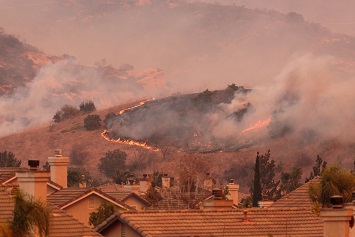The destructive wildfires throughout California have resulted in the loss of life and property and are stretching the resources to fight them. As we progress into late summer and fall, the danger will continue. Everyone must take precautions and stay aware of weather conditions to prevent human-caused fires. This is also the time to ensure a defensible perimeter is maintained around your property and repairs are made to keep blowing embers from entering structures.
Whether wildfires are near or far, we are also forced to deal with the smoke that results from them. Wildfire smoke contains chemicals, gases, and fine particles that can harm health. The greatest hazard comes from breathing fine particles in the air, which can reduce lung function; worsen asthma and other existing heart and lung conditions; and cause coughing, wheezing, and difficulty breathing.
The smallest and usually the most harmful particulate matter is PM2.5 (solid particles and liquid droplets suspended in air with an aerodynamic diameter of 2.5 micrometers or smaller). Emergency regulations issued by the California division of the Occupational Safety and Health Administration (Cal/OSHA) entitled Protection from Wildfire Smoke apply to workplaces and operations where the current Air Quality Index (AQI) for PM2.5 particulate is 151 or greater (“unhealthy”) and where employers should reasonably anticipate that employees may be exposed to wildfire smoke. Reference section 5141.1 for details on the scope and application of this regulation. Employers are required to determine employee exposure to PM2.5 for worksites covered by this section, before each shift, and periodically thereafter as needed.
The regulation requires the following:
- Identification of harmful exposures
- Communication
- Training and instruction
- Control of harmful exposures
- Specific particulate sampling requirements if an employer opts to monitor employee exposure with a direct reading instrument
Additional information about employer requirements and resources for maintaining worker safety in wildfire smoke can be found on the Department of Industrial Relations website at https://www.dir.ca.gov/dosh/worker-health-and-safety-in-wildfire-regions.html.
Of course, wildfire smoke is more than just an occupational hazard. It affects us all even when we’re off the job. The health effects from smoke are especially of concern to vulnerable individuals, including seniors and small children and persons with respiratory conditions like asthma, emphysema, and chronic bronchitis. Even the healthiest among us experience eye irritation and a scratchy throat when smoke fills the air.
Steps to take during wildfire smoke events include staying indoors, closing windows, and turning off evaporative coolers. Your eyes are your best tools to determine if it is safe to be outside. Use the 5-3-1 Method. If visibility is:
- Under 5 miles, the air quality is unhealthy for young children; adults over age 65; pregnant women; and people with heart and/or lung disease, asthma, or other respiratory illness. Outdoor activity should be minimized.
- Around 3 miles, young children; adults over age 65; pregnant women; and people with heart and/or lung disease, asthma, or other respiratory illness should avoid all outdoor activities.
- Around 1 mile, the air quality is unhealthy for everyone. People should remain indoors and avoid all outdoor activities, including running errands. Unless an evacuation order has been issued, stay inside your home, an indoor workplace, or a safe shelter.
Stay aware of the situation in your area, and monitor fire weather reports from the National Weather Service and air quality advisories from your local authorities. Advance preparation and attention to fire safety can help all of us be healthier during this upcoming season.
 Trina Caton is Assistant Vice President in the Loss Control Department of Keenan, an industry-leading California insurance brokerage and consulting firm for healthcare organizations and public agencies. Trina currently directs and oversees Loss Control internal operations/resources of the department statewide. She has a thorough knowledge of occupational and environmental regulations and is dedicated to making workplaces safer. Trina Caton is Assistant Vice President in the Loss Control Department of Keenan, an industry-leading California insurance brokerage and consulting firm for healthcare organizations and public agencies. Trina currently directs and oversees Loss Control internal operations/resources of the department statewide. She has a thorough knowledge of occupational and environmental regulations and is dedicated to making workplaces safer. |

